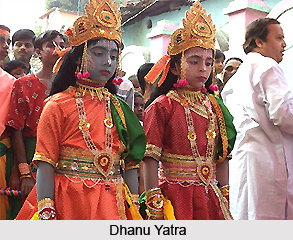 Dhanu Yatra is celebrated as a commemoration of Lord Krishna`s visit to Mathura. It is a distinctive form of annual festivity, in which the small isolated Bargah town of Orissa turns into a massive open-air theatre. Dhanu Yatra literally means `Bow Yatra`, as in archery. This is mainly a form of Krishna Lila that is peculiar to western Orissa. This art is conceived by the chiefs of Bargarh and Ambapali villages in Bargarh district during the mid-nineteenth century, it is held open-air at different locations in a wide area over twelve days. Ambapali becomes Gopapura and Bargarh, the Mathura of Krishna myths. The river Jira dividing the villages becomes the river Jamuna. Formerly Dhanu Yatra occurred in mime, as background singers in chorus delivered episodes from the medieval Oriya epic, Mathura mangala i.e. `Panegyric of Mathura`. Now prose dialogue has been introduced. All performers are amateurs belonging to both villages. Villagers gather in thousands to witness the performance. The mode of presentation provides scope for mass participation as well.
Dhanu Yatra is celebrated as a commemoration of Lord Krishna`s visit to Mathura. It is a distinctive form of annual festivity, in which the small isolated Bargah town of Orissa turns into a massive open-air theatre. Dhanu Yatra literally means `Bow Yatra`, as in archery. This is mainly a form of Krishna Lila that is peculiar to western Orissa. This art is conceived by the chiefs of Bargarh and Ambapali villages in Bargarh district during the mid-nineteenth century, it is held open-air at different locations in a wide area over twelve days. Ambapali becomes Gopapura and Bargarh, the Mathura of Krishna myths. The river Jira dividing the villages becomes the river Jamuna. Formerly Dhanu Yatra occurred in mime, as background singers in chorus delivered episodes from the medieval Oriya epic, Mathura mangala i.e. `Panegyric of Mathura`. Now prose dialogue has been introduced. All performers are amateurs belonging to both villages. Villagers gather in thousands to witness the performance. The mode of presentation provides scope for mass participation as well.
The origin of Dhanu yatra can be traced back to the times of British regime. The year 1999 witnessed the celebration of its golden jubilee. The yatra lasts for a period of seven to eleven days and falls on the full-moon day of `Pausa` i.e. `Pausa Purnima`.
The Balya Ma i.e. childhood play of Krishna, from the killing of the demoness Putana to the subduing of the snake-monster Kaliya, is performed in Ambapali. In Bargarh a spectacular procession takes place of the tyrant king Kamsa mounted on an elephant. When accompanied by drummers and dancers, the procession winds its way through the streets. Kamsa behaves like a real king, stopping and fining anybody coming in front of him by car or motorcycle. Then he is led to an elaborately decorated temporary pavilion. Krishna and his brother Balarama, escorted by Kamsa`s courtier Akrura, arrive from Ambapali in a chariot drawn by horses. The fight ensues and the event ends with Kamsa`s slaying.




















